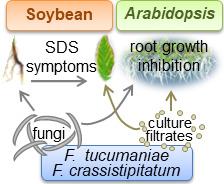当前位置:
X-MOL 学术
›
Plant Pathol.
›
论文详情
Our official English website, www.x-mol.net, welcomes your feedback! (Note: you will need to create a separate account there.)
Pathogenicity and toxicity of Fusarium tucumaniae and Fusarium crassistipitatum to soybean and Arabidopsis thaliana
Plant Pathology ( IF 2.7 ) Pub Date : 2020-09-26 , DOI: 10.1111/ppa.13286 Romina G. Rosati 1 , Rocío S. Ramos 1 , María M. Scandiani 2 , Alicia G. Luque 2 , Claudia P. Spampinato 1
Plant Pathology ( IF 2.7 ) Pub Date : 2020-09-26 , DOI: 10.1111/ppa.13286 Romina G. Rosati 1 , Rocío S. Ramos 1 , María M. Scandiani 2 , Alicia G. Luque 2 , Claudia P. Spampinato 1
Affiliation

|
Sudden death syndrome (SDS) of soybean is a fungal disease caused by at least four distinct Fusarium species: F. tucumaniae, F. virguliforme, F. brasiliense, and F. crassistipitatum. All four species are present in Argentina. These fungi are soilborne pathogens that only colonize roots and cause root necrosis. However, damage also reaches the aboveground part of the plant, and foliar chlorosis and necrosis, followed by premature defoliation, can be observed. Although the pathogenicity and phytotoxicity of F. virguliforme has been well characterized, knowledge regarding disease development by other fungal species is scarce. In this study, two plant species, soybean (Glycine max) and Arabidopsis thaliana, and isolates from two fungal species, F. tucumaniae and F. crassistipitatum, were used to comparatively analyse the fungal pathogenicity and the phytotoxicity of volatile organic compounds (VOCs) and cell‐free culture filtrates. Fungal inoculation had a significant effect on plant growth, regardless of the plant species. In addition, infected soybean plants showed disease incidence and foliar and root symptoms. Inhibition of A. thaliana growth was not due to VOCs emitted by fungi. Instead, both pathogens were shown to produce toxins that caused typical SDS foliar symptoms in soybean and root length reduction in A. thaliana. As far as we know, this is the first report that demonstrates that F. tucumaniae and F. crassistipitatum affect A. thaliana growth and emit VOCs, and that F. crassistipitatum produces toxins.
中文翻译:

枯萎镰刀菌和尖镰孢对大豆和拟南芥的致病性和毒性
大豆突然死亡综合症(SDS)是一种真菌病,由至少四种不同的镰刀菌物种F引起。tucumaniae,˚F。virguliforme,˚F。brasiliense和˚F。凤眼莲。所有四个物种都存在于阿根廷。这些真菌是土壤传播的病原体,仅在根部定居并引起根部坏死。然而,损害也到达植物的地上部分,并且可以观察到叶绿化和坏死,然后过早脱叶。虽然F的致病性和植物毒性。疣状已经被很好地表征,关于其他真菌物种疾病发展的知识很少。在这项研究中,两个植物物种,大豆(Glycine max)和拟南芥,以及从两个真菌物种F中分离出来。tucumaniae和˚F。十字花科植物被用来比较分析挥发性有机化合物(VOC)和无细胞培养滤液的真菌致病性和植物毒性。真菌接种对植物的生长都有重要影响,而与植物的种类无关。此外,受感染的大豆植株还显示出发病率以及叶面和根部症状。抑制一个。拟南芥增长不是由于真菌释放的VOC。取而代之的是,这两种病原体均显示出可产生导致大豆SDS叶典型症状和A根长减少的毒素。拟南芥。据我们所知,这是第一个证明F的报告。tucumaniae和˚F。crassistipitatum影响一个。拟南芥的生长和EMIT挥发性有机化合物,并且˚F。十字花科会产生毒素。
更新日期:2020-09-26
中文翻译:

枯萎镰刀菌和尖镰孢对大豆和拟南芥的致病性和毒性
大豆突然死亡综合症(SDS)是一种真菌病,由至少四种不同的镰刀菌物种F引起。tucumaniae,˚F。virguliforme,˚F。brasiliense和˚F。凤眼莲。所有四个物种都存在于阿根廷。这些真菌是土壤传播的病原体,仅在根部定居并引起根部坏死。然而,损害也到达植物的地上部分,并且可以观察到叶绿化和坏死,然后过早脱叶。虽然F的致病性和植物毒性。疣状已经被很好地表征,关于其他真菌物种疾病发展的知识很少。在这项研究中,两个植物物种,大豆(Glycine max)和拟南芥,以及从两个真菌物种F中分离出来。tucumaniae和˚F。十字花科植物被用来比较分析挥发性有机化合物(VOC)和无细胞培养滤液的真菌致病性和植物毒性。真菌接种对植物的生长都有重要影响,而与植物的种类无关。此外,受感染的大豆植株还显示出发病率以及叶面和根部症状。抑制一个。拟南芥增长不是由于真菌释放的VOC。取而代之的是,这两种病原体均显示出可产生导致大豆SDS叶典型症状和A根长减少的毒素。拟南芥。据我们所知,这是第一个证明F的报告。tucumaniae和˚F。crassistipitatum影响一个。拟南芥的生长和EMIT挥发性有机化合物,并且˚F。十字花科会产生毒素。


























 京公网安备 11010802027423号
京公网安备 11010802027423号